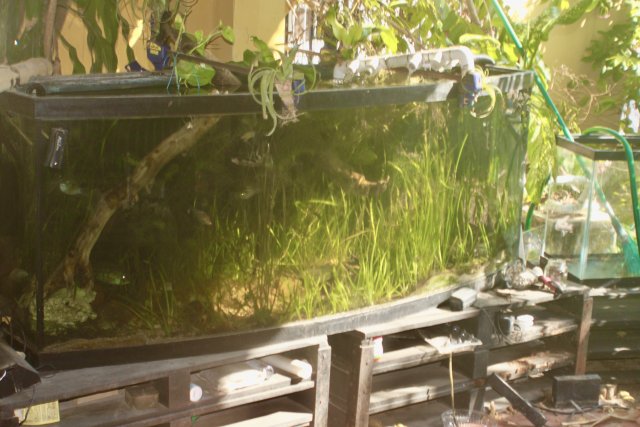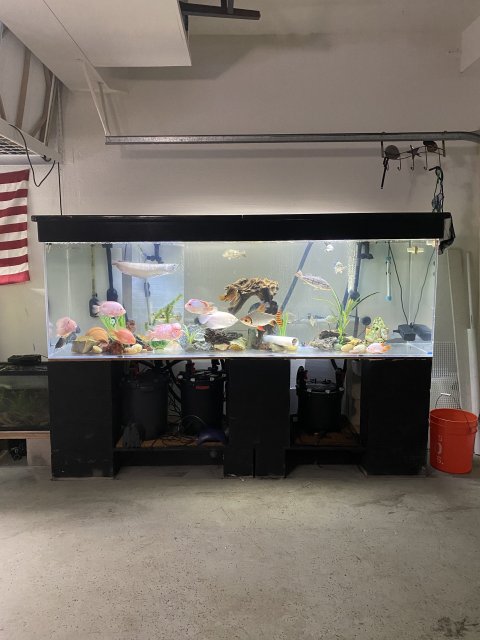That should probably cover it.In regards to an outage. With me having 2 sponges in the tank rated for 220 gallons each and having a backup air pump during these outages, wouldn't that cover that issue? Or am I wrong?
Bare bottom????
- Thread starter Mbuloverxxt
- Start date
You are using an out of date browser. It may not display this or other websites correctly.
You should upgrade or use an alternative browser.
You should upgrade or use an alternative browser.
Would you suggest I put a powerhead or something at the bottom of the tank to blow whatever way settle at the bottom of the tank over ?That should probably cover it.
One problem in going bare bottom, because substrate has the ability to hold billions of beneficial bacteria in the its many interstitial spaces, many more than simple glass bottom, this means in a bare bottom tank your filter is the main center for biological action (not solely but main center). if your power goes out for any length time, halting flow to and from filters, much of the biological action becomes non-existent. and if you are at all overstocked ammonia can become problematic very quickly,
In a tank with substrate full of beneficial bacteria, and semi-microscopic detritus feeders (and a little under stocked) that biological action between fish, bacteria and other detritus consumers is still available for at least a slightly longer amount of time before the tank goes anoxic.
Plants and algae can also be of help in these power outage situations, and are not as often a part of stark bare bottom set ups.
Could you elaborate on these “other detritus” consumers?
I replaced my power head in my 55 recently with an FX6 I am cycling.
The power head was used to push waste from one end of the tank to the other (4ft) where my 306 cleans it up, keeping my bare tank actually bare! The single FX6 is now doing that job even better.
With 3 I cant imagine anything staying on the bottom of a bare tank for long with correct positioning.
The power head was used to push waste from one end of the tank to the other (4ft) where my 306 cleans it up, keeping my bare tank actually bare! The single FX6 is now doing that job even better.
With 3 I cant imagine anything staying on the bottom of a bare tank for long with correct positioning.
Detritus worms, microscopic Ciliates, Tardigrades (water bears), a host of rotifer species, tiny snails (I usually have tiny cone snails in the always working in the substrate, there are many tiny animals that help break down debris into more usable compounds by beneficial bacteria. Put a drop of detritus on a microscope slide, and there may be hundreds, all working within the system.Could you elaborate on these “other detritus” consumers?
Being a retired microbiologist may give me a different (some might say, skewed) out look about lots of aspects of the aquarium hobby

And on the island where I live, power outages (sometimes extended ones) are common, so having my tank able to survive long stretches, perhaps days without pumps running, and filtration are important, I find the more naturally I run things (using substrate like sand, plants(aquatic, and terrestrial), etc etc), the less problematic the outcome.

"retired microbiologist" doesn't exist,
 duanes
. Once in, ain't no out...
duanes
. Once in, ain't no out...
I do this, too: try to build an ecosystem from the bottom-up so that it gets established before there's particular predation pressure. Sand/gravel, wood, plants, snails, tubifex/annelids, ostracods, amphipods, maybe little native guppies ...and then the target fish. A richer system will modulate foibles in water parameters & you can skip an occasional feeding, too.
I do this, too: try to build an ecosystem from the bottom-up so that it gets established before there's particular predation pressure. Sand/gravel, wood, plants, snails, tubifex/annelids, ostracods, amphipods, maybe little native guppies ...and then the target fish. A richer system will modulate foibles in water parameters & you can skip an occasional feeding, too.
I’ve been running my 300 bare bottom with 3 fx filters 4.5.&6 similar to you but im
Stocked a bit more
I’ve had no issues with it I run two power heads down low to keep debits from settling along with 2 big air stones
I can’t imagine putting gravel or sand in a tank this size cleaning that sounds like a night mare
With the bare bottom I am able to directly remove anything left and i usual find some under a few of the bigger rocks and wood decor I have but it’s very simple To move them aside and siphon it out with a 1/2 hose & pvc pipe I’ve rigged up for water changes
My last tank was a 150 with gravel and took forever to clean due to using a gravel vacuum yes I’d use the python so never lifted a bucket but it still takes time to go thru 6-8 feet of tank
Bare bottom tanks have cut a lot of time out of that process for me.
from a maintenance POV I’d recommend it

Stocked a bit more
I’ve had no issues with it I run two power heads down low to keep debits from settling along with 2 big air stones
I can’t imagine putting gravel or sand in a tank this size cleaning that sounds like a night mare
With the bare bottom I am able to directly remove anything left and i usual find some under a few of the bigger rocks and wood decor I have but it’s very simple To move them aside and siphon it out with a 1/2 hose & pvc pipe I’ve rigged up for water changes
My last tank was a 150 with gravel and took forever to clean due to using a gravel vacuum yes I’d use the python so never lifted a bucket but it still takes time to go thru 6-8 feet of tank
Bare bottom tanks have cut a lot of time out of that process for me.
from a maintenance POV I’d recommend it

I went from a 260gallon with 1 - 1.5" sized "Mexican river rock" substrate to crush coral "sand", and can say that the sand is so much more easier to siphon. Probably even easier with a bare bottom.
With regards to your canister pump being damaged by the sand, would that depend on where the intake is placed and if the return is blowing sand around? I've got an external overflow with one return at the surface and one at a 45* down. I also have a closed loop with an intake 4" from the sand substrate with no issues. I bring this up in case you really do like sand, but are just concerned with sucking up sand. good luck.
With regards to your canister pump being damaged by the sand, would that depend on where the intake is placed and if the return is blowing sand around? I've got an external overflow with one return at the surface and one at a 45* down. I also have a closed loop with an intake 4" from the sand substrate with no issues. I bring this up in case you really do like sand, but are just concerned with sucking up sand. good luck.
My daughters Axolotl tank is bare bottom... it is tons easier to maintain than tanks with substrate. If you are down the the bare bottom look your tank will most likely be much healthier than if it had substrate. There are no down sides that I am aware of.
Thousands of tanks with FX6's run sand substrate without any issues. I have run many canister filters on sand bottom tanks and never had a problem (I run sumps now and no longer run canisters).
Thousands of tanks with FX6's run sand substrate without any issues. I have run many canister filters on sand bottom tanks and never had a problem (I run sumps now and no longer run canisters).
I have a really good cleaning crew in my 180 the different fish and trumpet snails do 80% of the work for me , but I had to remove all the sand out of both my oscar tanks due to how messy they are and nothing else In there to help break it down further meaning I was constantly in there cleaning, I think the filters would be fine with the sand but without a fishy clean up crew I find regardless of quality of filters waste soon ruins the sand if your not on top of gravel vacuuming which is hard when you have a decorated tank. Bare bottom is alot better all round other then appearance in my opinion.


